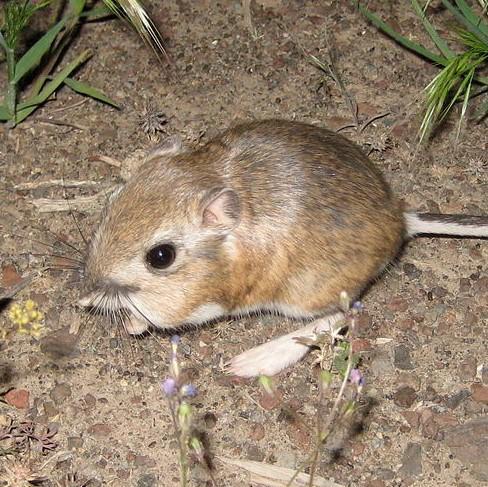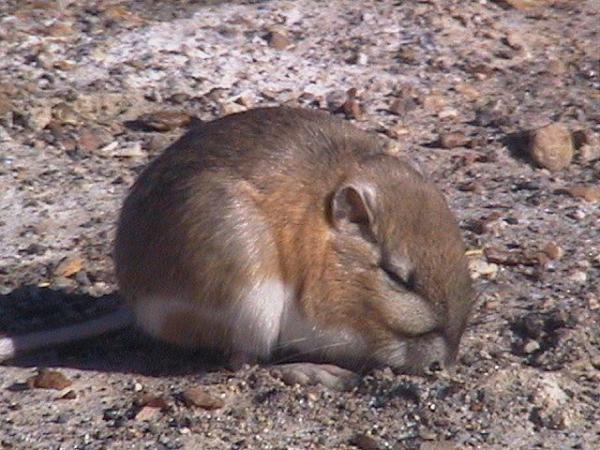
Kangaroo rats (Dipodomys) are interesting and unique mammals, and it is for this reason why many people consider keeping one as a pet. Despite the name "kangaroo", this tiny animal is a rodent; the name comes from its long hind legs and huge tail, which it uses to keep its balance.
There are actually about 20 species of this genus living in arid and desert areas, although they all look very similar to each other. Their small size and cuteness belies vulnerability as, in the wild, they are susceptible prey to coyotes, badgers and owls.
If you intend on keeping a kangaroo rat as a pet, there are certain factors you will need to consider when making your decision to adopt want. Do you want to know whether it is really possible to keep a kangaroo rat as a pet and tame it? Stay with us at AnimalWised and learn all about its behavior and needs.
Is it possible to have a kangaroo rat as a pet?
The kangaroo rat is a rodent with a different morphology - that is, physical structure - to what many are used to. Its surprising and unique appearance is what leads many people to consider keeping this animal as a pet. After all, people keep hamsters and rats as pets, so why not a kangaroo rat?
The kangaroo rat is surprisingly durable animal that can adapt easily to dry and arid climates, feeding on small insects and seeds. Kangaroo rats enjoy running long distances, cleaning themselves with sand warmed up by the sun and digging deep, strategically placed burrows to protect themselves from predators.
This means it's an animal that requires high amounts of exercise, plenty of available space, and a particular temperature and natural light during the day. Ask yourself if you can meet these requirements, because a kangaroo rat is not a companion animal. If you are looking for reciprocated affection, perhaps another choice in pet would be better for you.

Where can you get a kangaroo rat?
We at AnimalWised do not consider the kangaroo rat to be an animal that should ideally be held in captivity, as this will only achieve a stressed, sad and apathetic little rodent. They may never be able to reproduce nor learn what it means to live in the wild. Still, if you're determined to get a pet kangaroo rat, you should understand some key points:
- Kangaroo rats are sensitive and fearful animals. Never try to catch one in the wild as it could suffer a heart attack right there and then, or even during transportation.
- If you are thinking about buying one, it is fundamental that the seller is certified by CITES, the Convention on International Trade of Endangered Species. Without this certificate, not only would you be encouraging illegal and ecologically detrimental trade, but you may be getting a sick rodent that could transmit a disease to you.
- Be suspicious of private sellers - don't fund the illegal trading of animals.
- Look for them in shelters, because these animals are difficult to look after properly and are often abandoned.

Taking care of kangaroo rats
Having a kangaroo rat as a pet means that you'll need to care for its unique requirements. Anyone that keeps an animal only to observe it and play with it without paying attention to its specific requirements as a living creature shouldn't consider getting any.
For this reason, and so that you understand why this animal isn't generally suitable to have at home, we are going to explain what you would need in order to have a kangaroo rat as a pet:
- A large plot of land where it can run and dig as much as it wants. To prevent it from escaping, you should consider fencing off the area; a difficult task since it is a very small rodent. The substrate of the ground should be soft and thin so it can carry out its natural instinct of digging and can make its "nests".
- Its diet is complicated because it is based on roots, leaves and seeds, such as the goosefoot or flageolet. It may be difficult to obtain local flora from the United States.
- It will need other kangaroo rats to socialize with.

Behavior of kangaroo rats
The behavior of the kangaroo rat in a domestic setting is not well documented, as they have not been popular pets for any great length of time.
We do know that, in the wild, they drink very little to no water as they get most of their hydration from the legumes and seeds they eat. They store this food in furry pouches on the outside of their mouths.
Kangaroo rats have a very agile body and can jump up to 9 feet (2.75 m) when avoiding predators. They can even sense the movement of an owl from vibrations and, with such sensitivity, it is fair to assume that it will not willingly accept being touched and "trained" by humans.

Do you know anything else about the kangaroo rat as a pet that we might have missed? Let us know in the comments below and share some fun facts with the community.
Other uncommon animals you might consider as a pet include the capybara and the long-tailed chinchilla. You can learn more about the kangaroo rat in its natural habitat with our article on the native animals of Utah.
If you want to read similar articles to The Kangaroo Rat as a Pet, we recommend you visit our What you need to know category.